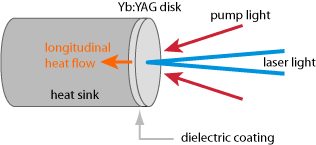| Home | Orbit | Satellite | Power Link | Comm Link | Earth Stations | Cost/Timeline | Employees |
Collection
There are two stages to the power transmission of our system. The first stage involves capturing solar energy using the large solar arrays on our L1 satellites. We estimate that we will be able to collect 1.4kW/m2 including a 2% increase in incident solar radiation due to the shortened distance to the sun in halo orbit, resulting in 882MW of power incident on each satellite. Our harvesting satellite will use photodiodes to convert the collected electricity to laser for transfer to the distribution satellite. Estimating 20% solar panel efficiency and 50% efficiency in converting DC power to laser power, our laser power link will transmit 87.5MW of power to the distribution satellite.
As the most powerful solid state experimental military lasers are approximately 150kWs continuous wave, having an 87.5MW laser that can operate continuously for 20 years will require some additional research and development. With the rapidly advancing state of electronics, it's assumed that this technology will be available in time for launch. Using a disk laser would work well for this application as the gain medium is mounted directly on the heatsink, so even through the amount of dissipated energy is tremendous, it's far easier to transport it away from the gain medium. While these lasers scale well in power by the disk area, these still only operate in the kilowatts, and so are still far from the necessary level of development.

Distribution
Using monochromatic photovoltaics we estimate that our distribution satellite will collect 95% of the transmitted laser power. At 80% conversion to 30GHz microwaves (using an RF amplifier) our distribution satellite will be able to beam 66.5MW to the earth's surface. The satellite will transmit using a parabolic dish 150m in diameter, giving it a gain of 93.5dBi. The power will transmit with a beamwidth of 0.0036o which will cause the received beam to be approximately 2.38km in diameter. Using Yang Chun and V. L. Savvin's work on rectenna efficiency, we predict that a 9km2 rectenna will be able to convert 90% of the RF power to electricity. For our given frequency and transmit power, atmospheric absorption was calculated to be 0.2dB and therefore considered negligible.
| Tx Power | 108.23dBm |
| Tx Gain | 93.5dBi |
| Path Loss | 213dB |
| Rx Gain | 120dBi |
| Rx Power | 108.23dBm |
Estimating a 3% power loss in moving the collected power to the grid, we conclude 58.05MW of power will be added to the grid per collection satellite. The combined link ends up operating at 6.6% efficiency.
| Stage | Power Output (MW) | Efficiency |
| Solar Power | 875 | 1.0 |
| Solar Array | 175 | 0.2 |
| Laser | 87.5 | 0.5 |
| L1 Satellite | 87.5 | 0.25 |
| Laser PV Receiver | 83.125 | 0.95 |
| Microwave Antenna (DC to RF) | 66.5 | 0.8 |
| GEO Satellite | 66.5 | 0.76 |
| Rectenna | 59.85 | 0.9 |
| Grid Interface | 58.05 | 0.97 |
| Ground Station | 58.05 | 0.873 |
| Total System | 58.05 | 0.066 |
